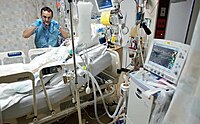
Photo from wikipedia
OBJECTIVES To compare sleep, work hours, and behavioral alertness in faculty and fellows during a randomized trial of nighttime in-hospital intensivist staffing compared with a standard daytime intensivist model. DESIGN… Click to show full abstract
OBJECTIVES To compare sleep, work hours, and behavioral alertness in faculty and fellows during a randomized trial of nighttime in-hospital intensivist staffing compared with a standard daytime intensivist model. DESIGN Prospective observational study. SETTING Medical ICU of a tertiary care academic medical center during a randomized controlled trial of in-hospital nighttime intensivist staffing. PATIENTS Twenty faculty and 13 fellows assigned to rotations in the medical ICU during 2012. INTERVENTIONS As part of the parent study, there was weekly randomization of staffing model, stratified by 2-week faculty rotation. During the standard staffing model, there were in-hospital residents, with a fellow and faculty member available at nighttime by phone. In the intervention, there were in-hospital residents with an in-hospital nighttime intensivist. Fellows and faculty completed diaries detailing their sleep, work, and well-being; wore actigraphs; and performed psychomotor vigilance testing daily. MEASUREMENTS AND MAIN RESULTS Daily sleep time (mean hours [SD]) was increased for fellows and faculty in the intervention versus control (6.7 [0.3] vs 6.0 [0.2]; p < 0.001 and 6.7 [0.1] vs 6.4 [0.2]; p < 0.001, respectively). In-hospital work duration did not differ between the models for fellows or faculty. Total hours of work done at home was different for both fellows and faculty (0.1 [< 0.1] intervention vs 1.0 [0.1] control; p < 0.001 and 0.2 [< 0.1] intervention vs 0.6 [0.1] control; p < 0.001, respectively). Psychomotor vigilance testing did not demonstrate any differences. Measures of well-being including physical exhaustion and alertness were improved in faculty and fellows in the intervention staffing model. CONCLUSIONS Although no differences were measured in patient outcomes between the two staffing models, in-hospital nighttime intensivist staffing was associated with small increases in total sleep duration for faculty and fellows, reductions in total work hours for fellows only, and improvements in subjective well-being for both groups. Staffing models should consider how work duration, sleep, and well-being may impact burnout and sustainability.
Journal Title: Critical Care Medicine
Year Published: 2019
Link to full text (if available)
Share on Social Media: Sign Up to like & get
recommendations!